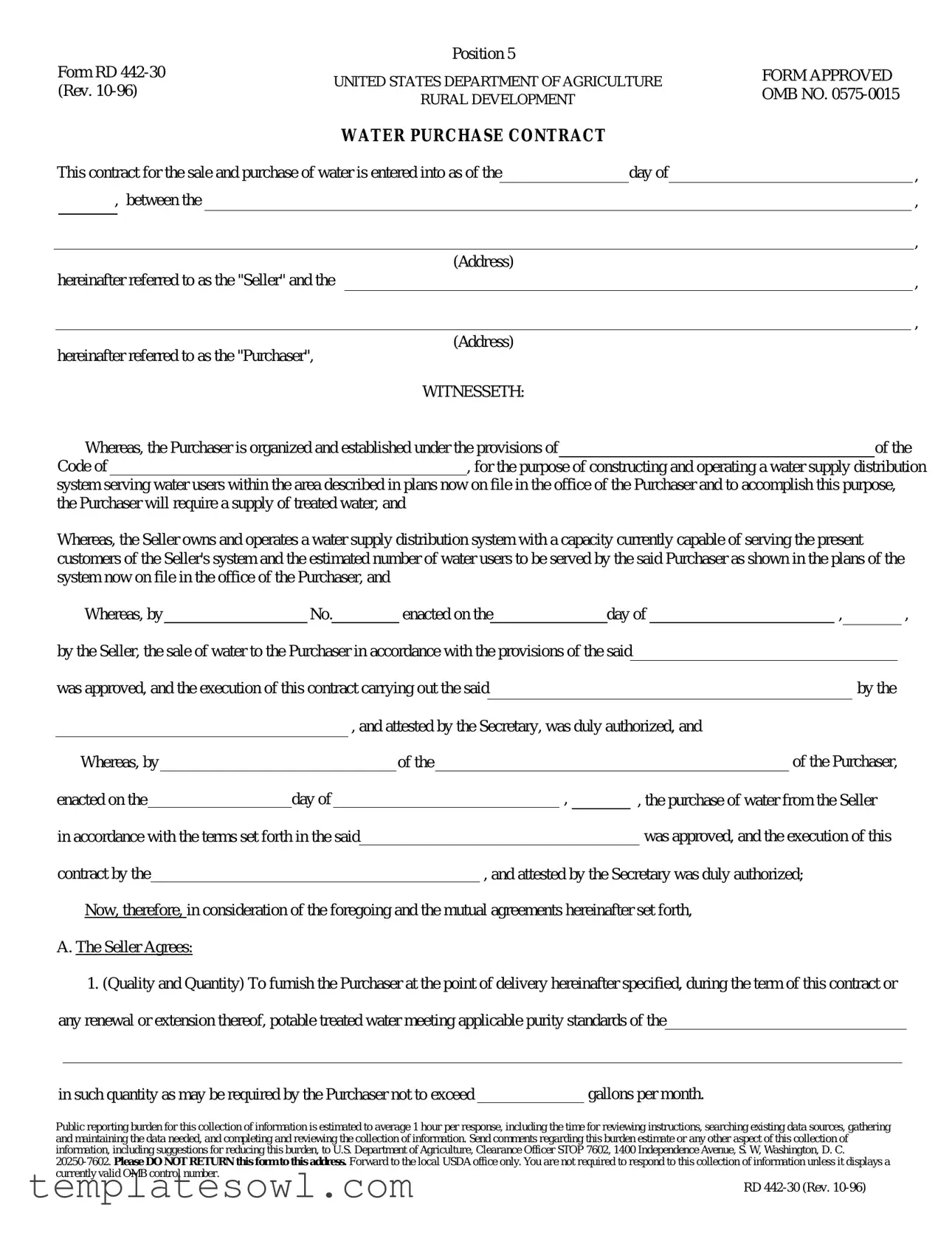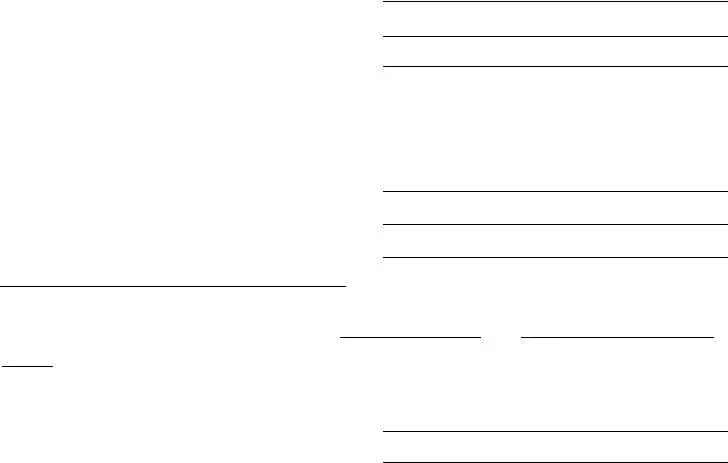
|
Form RD 442-30 |
|
Position 5 |
|
|
|
|
|
|
UNITED STATES DEPARTMENT OF AGRICULTURE |
FORM APPROVED |
|
(Rev. 10-96) |
OMB NO. 0575-0015 |
|
|
RURAL DEVELOPMENT |
|
|
|
|
|
|
|
WATER PURCHASE CONTRACT |
|
|
|
|
|
|
This contract for the sale and purchase of water is entered into as of the |
day of |
, |
|
|
|
, between the |
|
|
|
|
|
|
|
|
|
, |
|
|
|
|
|
|
|
|
|
|
|
|
, |
|
|
|
|
|
|
|
|
|
|
|
|
|
|
|
|
|
|
|
(Address) |
|
|
|
|
|
|
hereinafter referred to as the ''Seller'' and the |
|
|
|
, |
|
|
|
|
|
|
|
|
|
|
|
|
, |
|
hereinafter referred to as the ''Purchaser'', |
|
(Address) |
|
|
|
|
|
|
|
|
|
|
|
|
|
|
|
|
|
|
|
|
|
|
|
WITNESSETH: |
|
|
|
|
|
|
|
Whereas, the Purchaser is organized and established under the provisions of |
|
|
|
of the |
|
Code of |
|
|
, for the purpose |
of constructing and operating a water supply distribution |
|
|
|
|
|
|
|
|
|
|
|
|
|
|
|
|
system serving water users within the area described in plans now on file in the office of the Purchaser and to accomplish this purpose, the Purchaser will require a supply of treated water, and
Whereas, the Seller owns and operates a water supply distribution system with a capacity currently capable of serving the present customers of the Seller's system and the estimated number of water users to be served by the said Purchaser as shown in the plans of the system now on file in the office of the Purchaser, and
Whereas, by |
|
|
No. |
|
|
enacted on the |
|
day of |
, |
|
|
|
, |
|
|
|
|
|
|
|
|
|
|
|
|
|
|
|
|
|
|
|
|
|
|
|
by the Seller, the sale of water to the Purchaser in accordance with the provisions of the said |
|
|
|
|
|
|
|
|
|
|
|
|
was approved, and the execution of this contract carrying out the said |
|
|
|
|
|
|
|
|
|
|
by the |
|
|
|
|
|
|
|
|
|
, and attested by the Secretary, was duly authorized, and |
|
|
|
|
|
|
Whereas, by |
|
|
|
|
|
|
|
of the |
|
|
|
|
|
|
|
of the Purchaser, |
|
enacted on the |
|
day of |
|
|
|
|
|
|
|
, |
|
|
, the purchase of water from the Seller |
|
|
|
|
|
|
|
|
|
|
|
was approved, and the execution of this |
|
in accordance with the terms set forth in the said |
|
|
|
|
|
|
contract by the |
|
|
|
|
|
|
|
|
|
, and attested by the Secretary was duly authorized; |
|
Now, therefore, in consideration of the foregoing and the mutual agreements hereinafter set forth,
A. The Seller Agrees:
1.(Quality and Quantity) To furnish the Purchaser at the point of delivery hereinafter specified, during the term of this contract or any renewal or extension thereof, potable treated water meeting applicable purity standards of the
in such quantity as may be required by the Purchaser not to exceed |
|
gallons per month. |
Public reporting burden for this collection of information is estimated to average 1 hour per response, including the time for reviewing instructions, searching existing data sources, gathering and maintaining the data needed, and completing and reviewing the collection of information. Send comments regarding this burden estimate or any other aspect of this collection of information, including suggestions for reducing this burden, to U.S. Department of Agriculture, Clearance Officer STOP 7602, 1400 Independence Avenue, S. W, Washington, D. C.
20250-7602. Please DO NOT RETURN this form to this address. Forward to the local USDA office only. You are not required to respond to this collection of information unless it displays a currently valid OMB control number.
2. (Point of Delivery and Pressure) That water will be furnished at a reasonably constant pressure calculated at
from an existing |
|
inch main supply at a point located |
.
If a greater pressure than that normally available at the point of delivery is required by the Purchaser, the cost of providing such greater pressure shall be borne by the Purchaser. Emergency failures of pressure or supply due to main supply line breaks, power failure, flood, fire and use of water to fight fire, earthquake or other catastrophe shall excuse the Seller from this provision for such reasonable period of time as may be necessary to restore service.
3.(Metering Equipment) To furnish, install, operate, and maintain at its own expense at point of delivery, the necessary metering equipment, including a meter house or pit, and required devices of standard type for properly measuring the quantity of water delivered to the Purchaser and to calibrate such metering equipment whenever requested by the Purchaser but not more frequently than once every twelve (12) months. A meter registering not more than two percent (2%) above or below the test result shall be deemed to be accurate.
The previous readings of any meter disclosed by test to be inaccurate shall be corrected for themonths
previous to such test in accordance with the percentage of inaccuracy found by such tests. If any meter fails to register for any period, the amount of water furnished during such period shall be deemed to be the amount of water delivered in the corresponding period immediately prior to the failure, unless Seller and Purchaser shall agree upon a different amount. The metering equipment shall be read on
. An appropriate official of the Purchaser at all reasonable times shall have access to
the meter for the purpose of verifying its readings. |
|
|
|
|
|
|
|
|
|
|
|
4. (Billing Procedure) To furnish the Purchaser at the above address not later than the |
|
|
|
day of each month, |
|
with an itemized statement of the amount of water furnished the Purchaser during the preceding month. |
|
|
|
|
B. The Purchaser Agrees: |
|
|
|
|
|
|
|
|
|
|
|
|
|
1. (Rates and Payment Date) To pay the Seller, not later than the |
|
day of each month, for water delivered in |
|
accordance with the following schedule of rates: |
|
|
|
|
|
|
|
|
|
|
|
a. $ |
|
for the first |
|
gallons, which amount shall also be the minimum rate per month. |
|
b. $ |
cents per 1000 gallons for water in excess of |
|
|
gallons but less than |
. |
|
|
|
|
|
|
|
|
|
|
|
|
|
|
|
gallons. |
|
|
|
|
|
|
|
|
|
|
|
|
|
c. $ |
cents per 1000 gallons for water in excess of |
|
|
gallons. |
|
|
|
|
|
|
|
|
|
|
|
|
|
|
|
|
2. (Connection Fee) To pay as an agreed cost, a connection fee to connect the Seller's system with the system of the Purchaser,
|
|
|
|
|
the sum of |
|
dollars which shall cover any and all costs of the Seller for installation of the metering equipment |
and |
|
|
. |
C. It is further mutually agreed between the Seller and the Purchaser as follows:
1. (Term of Contract) That this contract shall extend for a term ofyears from the date of the initial delivery of any
water as shown by the first bill submitted by the Seller to the Purchaser and, thereafter may be renewed or extended for such term, or terms, as may be agreed upon by the Seller and Purchaser.
2. (Delivery of Water) Thatdays prior to the estimated date of completion of construction of the Purchaser's water
supply distribution system, the Purchaser will notify the Seller in writing the date for the initial delivery of water.
3.(Water for Testing) When requested by the Purchaser the Seller will make available to the contractor at the point of delivery, or other point reasonably close thereto, water sufficient for testing, flushing, and trench filling the system of the Purchaser during
construction, irrespective of whether the metering equipment has been installed at that time, at a flat charge of $ which will be paid by the contractor or, on his failure to pay, by the Purchaser.
4.(Failure to Deliver) That the Seller will, at all times, operate and maintain its system in an efficient manner and will take such action as may be necessary to furnish the Purchaser with quantities of water required by the Purchaser. Temporary or partial failures to deliver water shall be remedied with all possible dispatch. In the event of an extended shortage of water, or the supply of water available to the Seller is otherwise diminished over an extended period of time, the supply of water to Purchaser's consumers shall be reduced or diminished in the same ratio or proportion as the supply to Seller's consumers is reduced or diminished.
5.(Modification of Contract) That the provisions of this contract pertaining to the schedule of rates to be paid by the Purchaser for
water delivered are subject to modification at the end of everyyear period. Any increase or decrease in rates shall be based on a demonstrable increase or decrease in the costs of performance hereunder, but such costs shall not include increased capitalization of the Seller's system. Other provisions of this contract may be modified or altered by mutual agreement.
6.(Regulatory Agencies) That this contract is subject to such rules, regulations, or laws as may be applicable to similar agreements in this State and the Seller and Purchaser will collaborate in obtaining such permits, certificates, or the like, as may be required to comply therewith.
7.(Miscellaneous) That the construction of the water supply distribution system by the Purchaser is being financed by a loan made or insured by, and/or a grant from, the United States of America, acting through Rural Development of the United States Department of Agriculture, and the provisions here of pertaining to the undertakings of the Purchaser are conditioned upon the approval, in writing, of the State Director of Rural Development.
8.(Successor to the Purchaser) That in the event of any occurrence rendering the Purchaser incapable of performing under this contract, any successor of the Purchaser, whether the result of legal process, assignment, or otherwise, shall succeed to the rights of the Purchaser hereunder.
In witness whereof, the parties hereto, acting under authority of their respective governing bodies, have caused this contract to be duly
executed in |
|
counterparts, each of which shall constitute an original. |
Seller:
|
|
By |
Attest: |
|
Title |
|
|
|
|
Secretary |
Purchaser:
Secretary
This contract is approved on behalf of Rural Development thisday of,
.
By
Title




